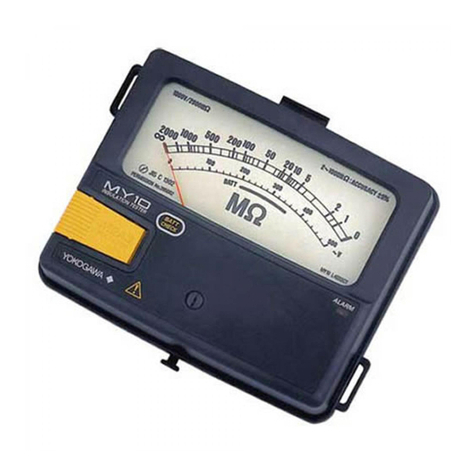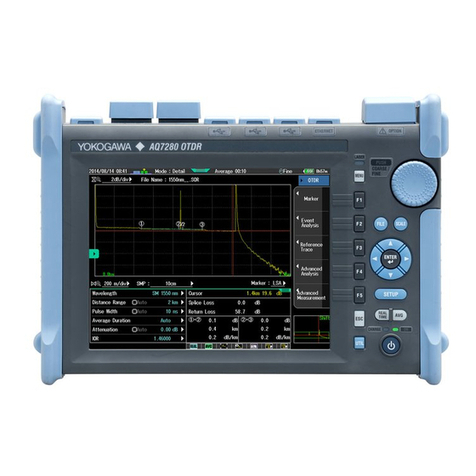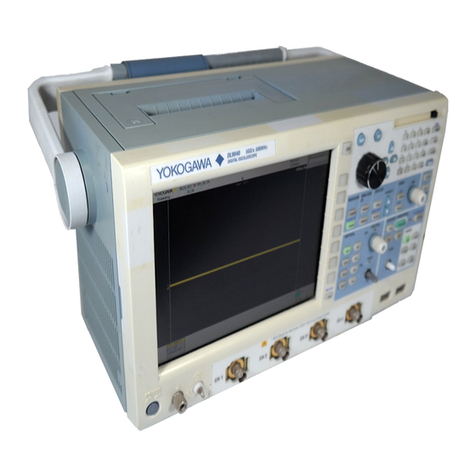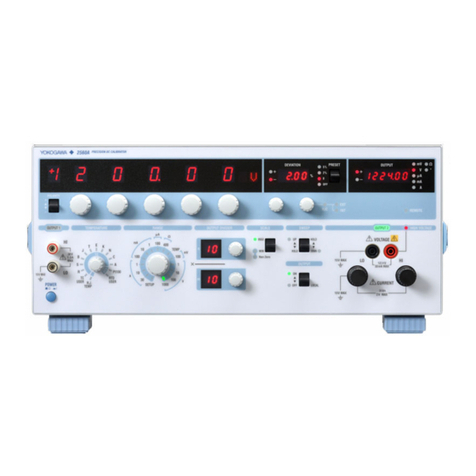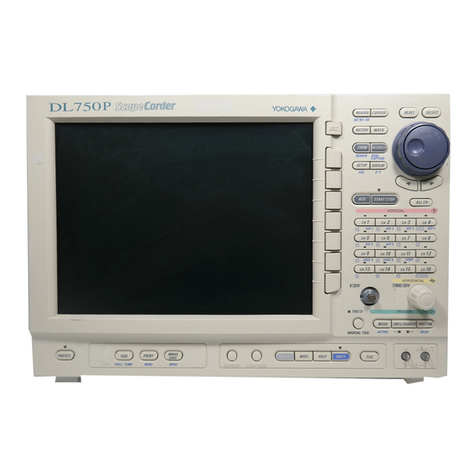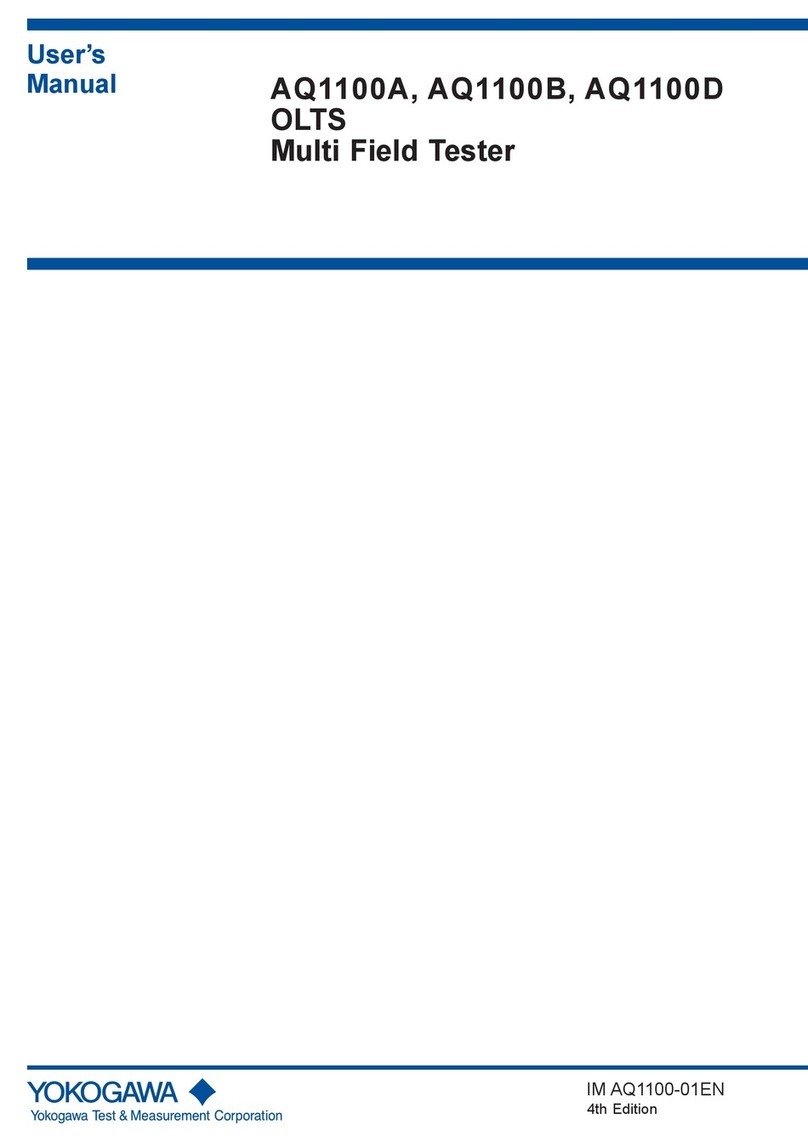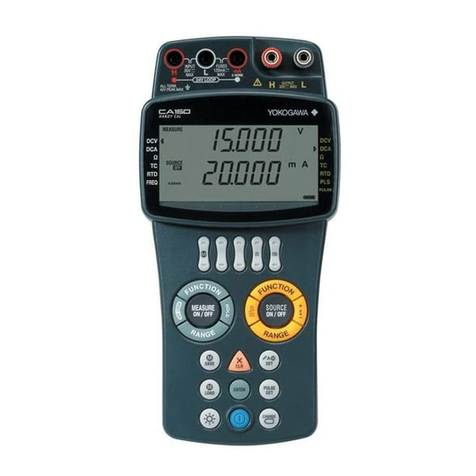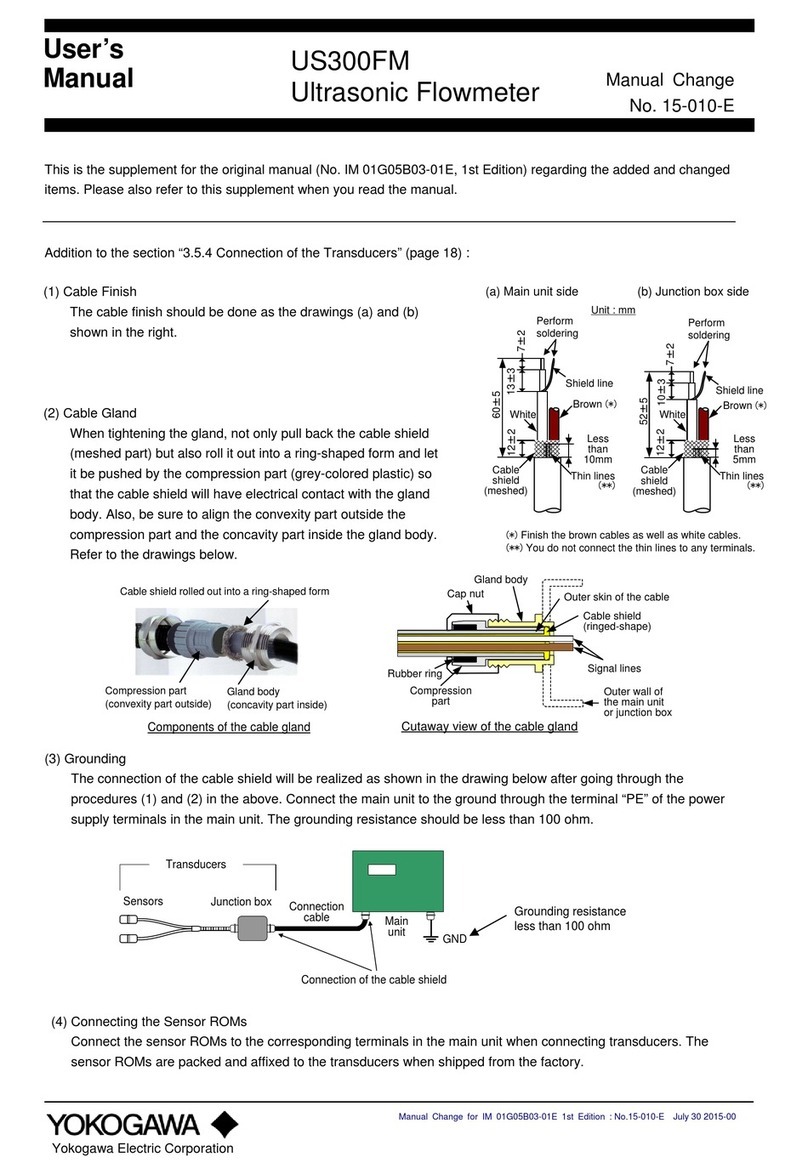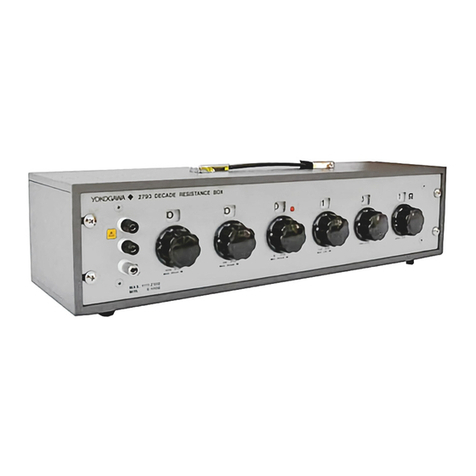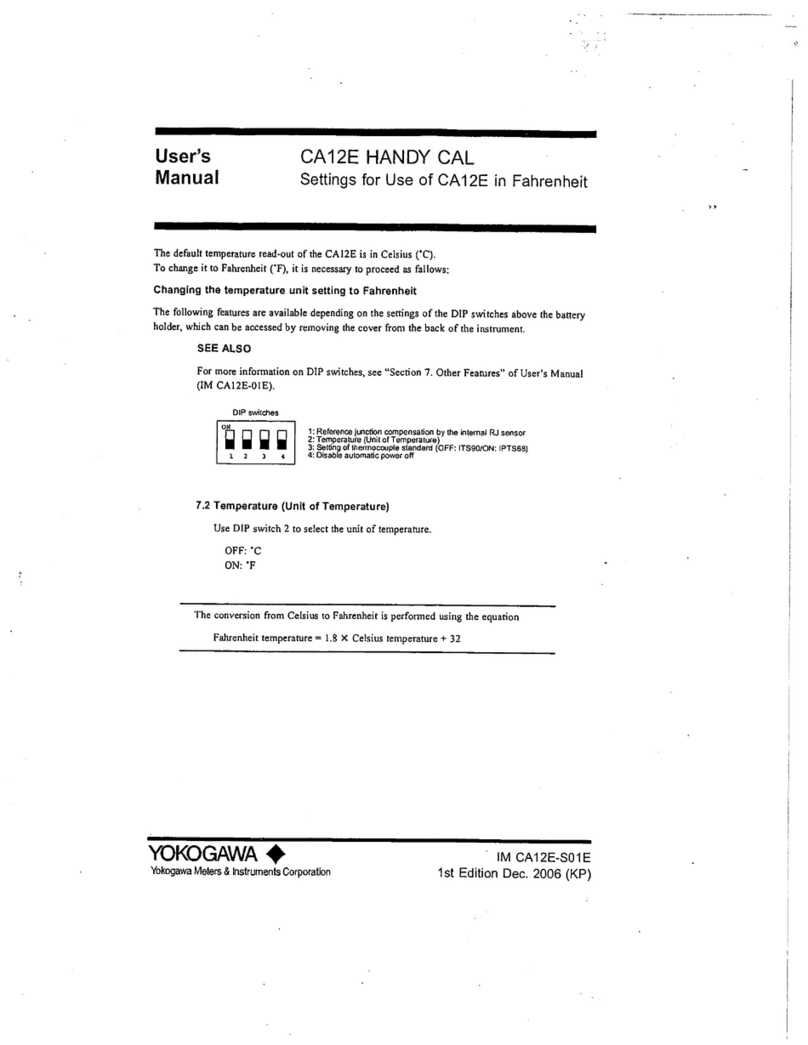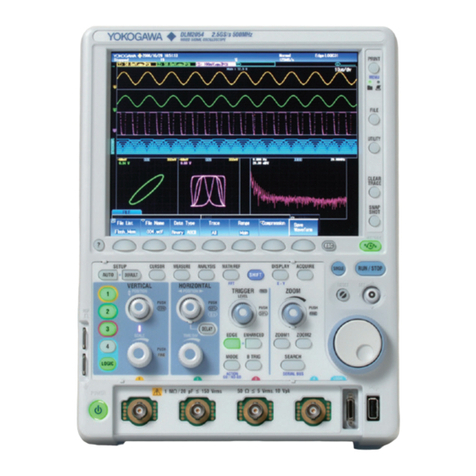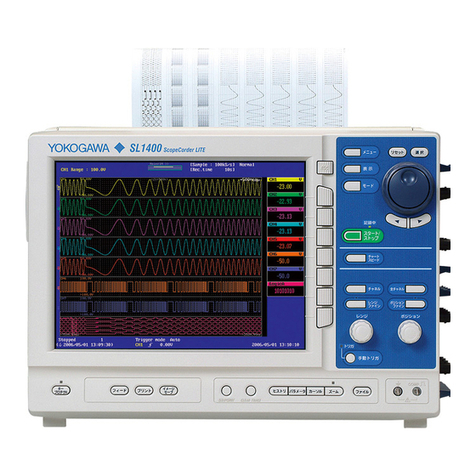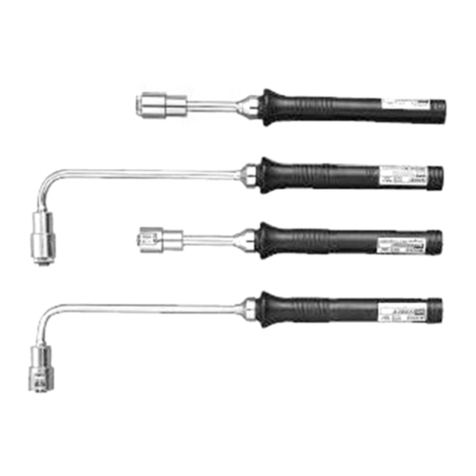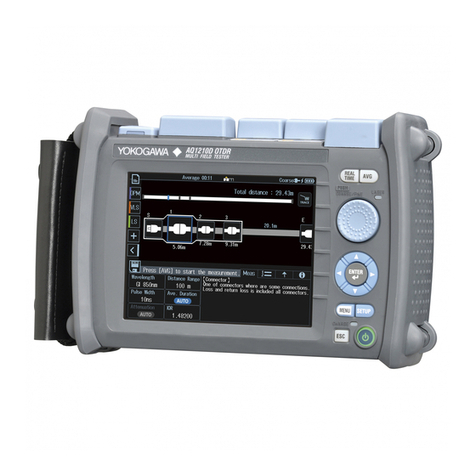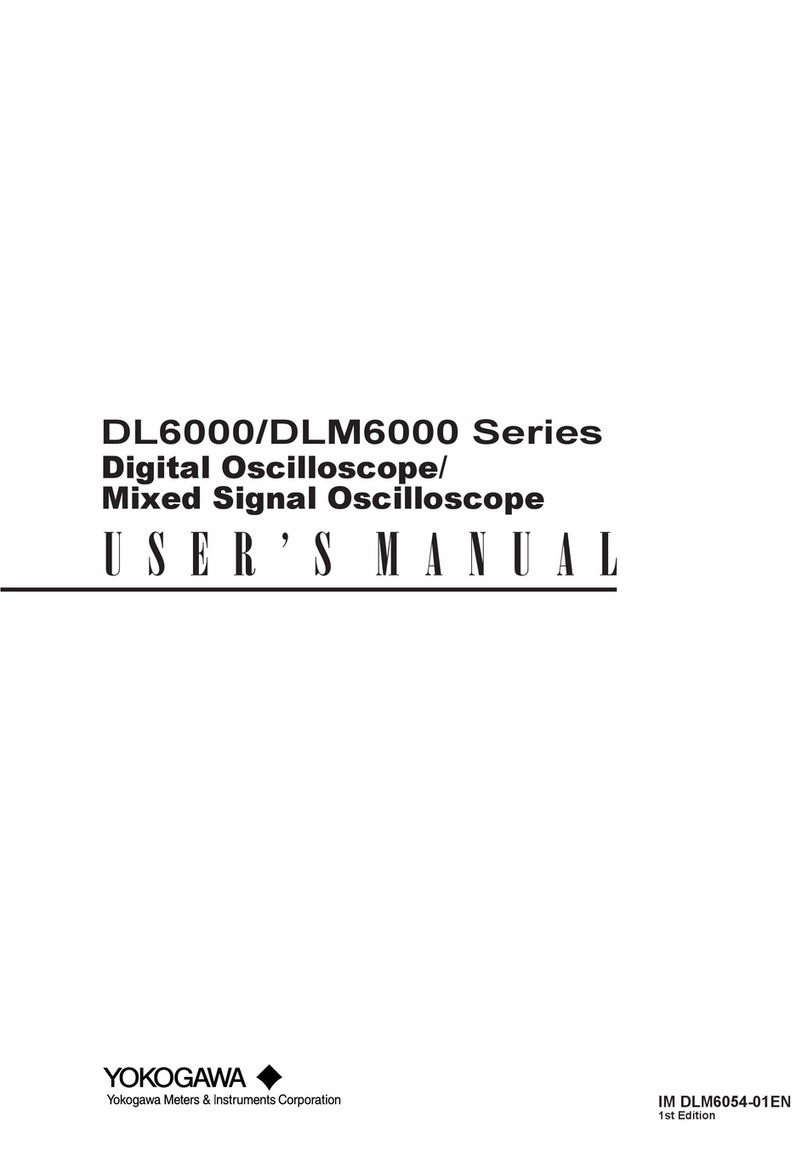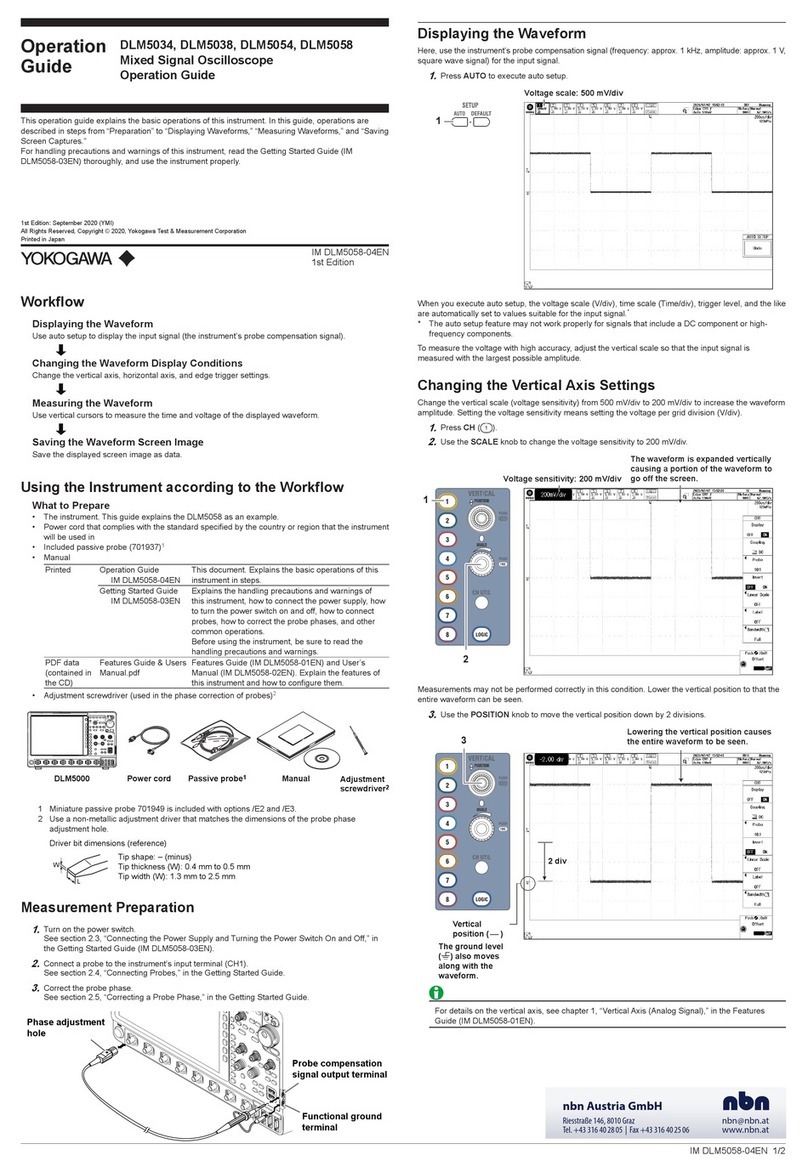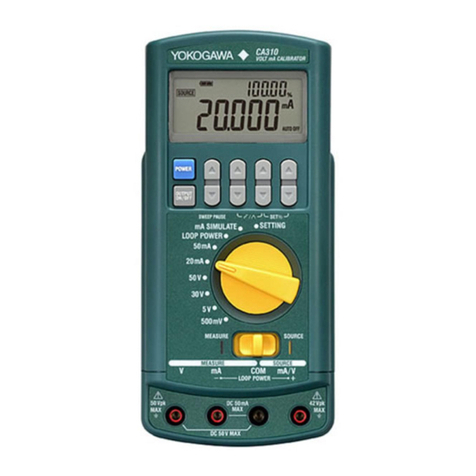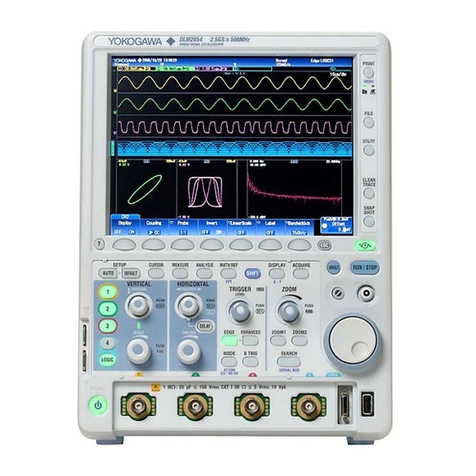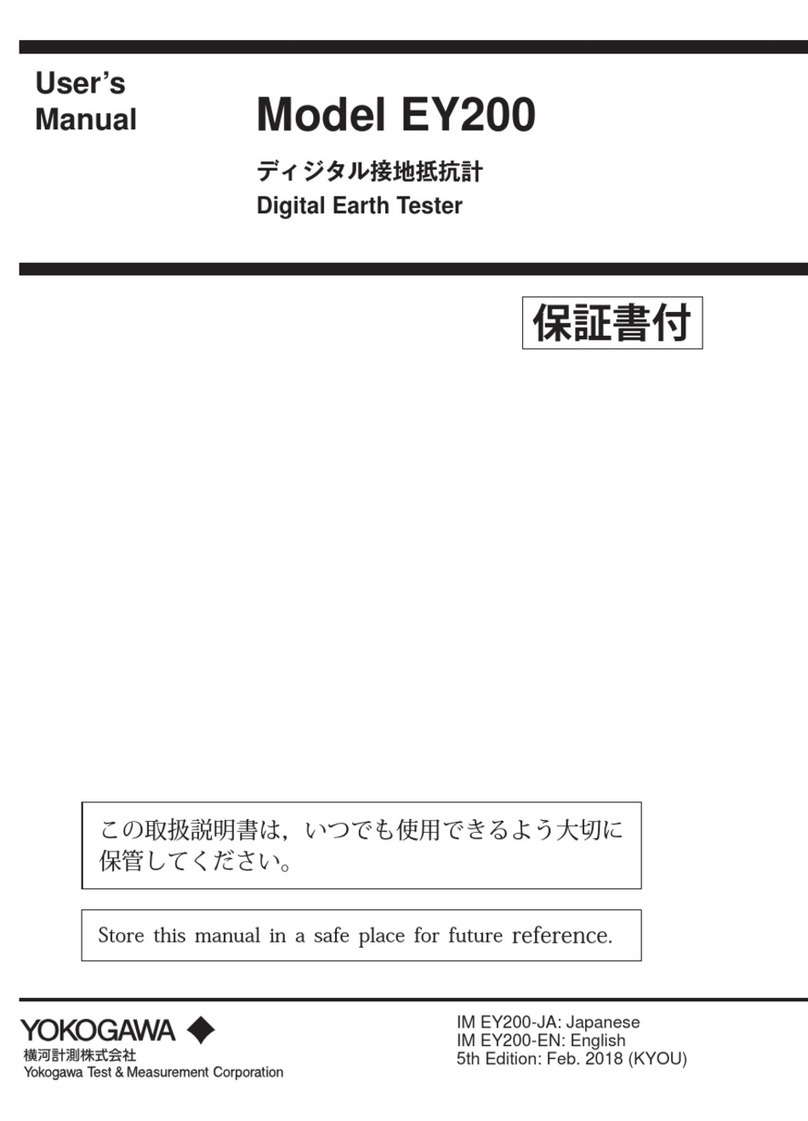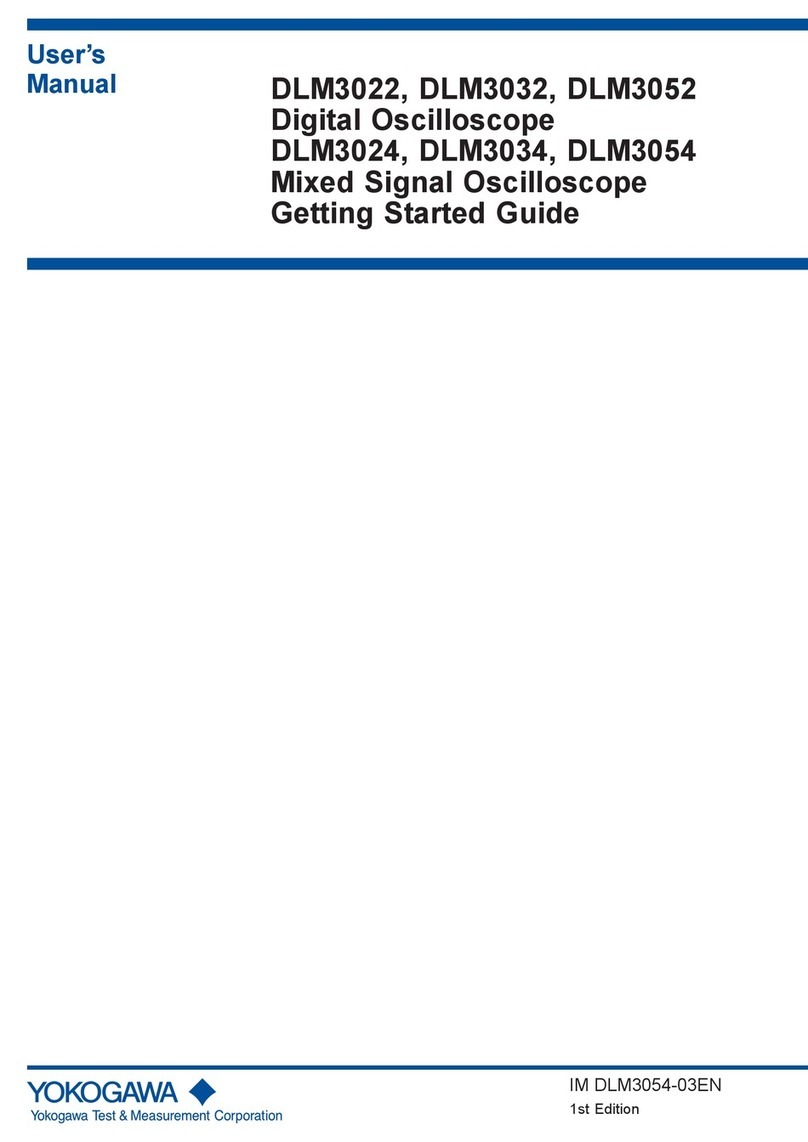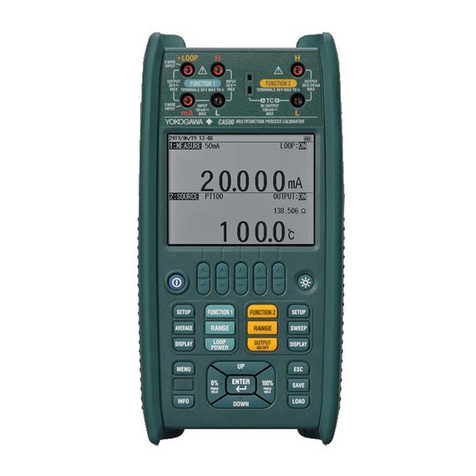
IM MY40 <P2>
General Specications
Operation temperature and humidity 0°C to 40°C at 90% RH or less (no condensation)
Storage temperature and humidity –10°C to 60°C at 70% RH or less (no condensation)
Battery Four AA-size (R6)
External dimensions Approx. 125 (W) × 103 (H) × 52.5 (D) mm
Weight Approx. 420 g (main unit and batteries only)
Approx. 600 g (main unit, batteries, protective cover, earth probe and line probe)
Safety standards EN 61010-1, EN 61010-2-030, EN 61010-031
Measurement category III (CAT III) 600 V
Insulation class 2
Indoor use, alititude 2000 m or less, pollution degree 2
EMC standards EN 61326-1 Class B, EN 61326-2-2
EMC Regulatory Arrangement in Australia and New Zealand
EN 55011 Class B Group 1
Korea Electromagnetic Conformity Standard
( 한국 전자파적합성기준 )
Effect of radiation immunity
(at the strength of radio-frequency
electromagnetic eld of 3 V/m)
Insulation resistance measurement
1st effective measuring range: ±(5% of rdg +12 dgt)
2nd effective measuring range: ±(10% of rdg +12 dgt)
AC voltage measurement: ±(5% of rdg +12 dgt)
Conductor resistance measurement: ±(10% of range)
Environmental standard EN 50581
Monitoring and control instruments including industrial monitoring and control instruments
■ Standard Accessories
Name Model No. Quantity
Protection cover 93013 1
Shoulder strap 99005 1
Line prob 98001 1
Earth probe 98002 1
Batteries --- 4
User's manual IM MY40-E 1
IM MY40-02EN 1
■ Optional Accessories
Name Model No. Description
1. Spare probe tip for
the line probe (Model 98001)
99011 105 mm, breaker pin
2. Hard case 93015 Houses both the main unit,
the line probe and the earth probe.
3. Accessory bag B9108XA Soft case:
approx. 100 (W)×190 (H)×40 (D) mm
3. B9108XA2. 930151. 99011
External Dimensions
125 (4.92)
103 (4.06)
52.5 (2.07)
Clr
Enter
Select
250V
1000V
500V
2000M
200M
OFF
600V MAX
V
125V
MEM
LIGHT
COMP
ALARM
INSULATION TESTER
1000V RELEASE
MEAS
PULL LOCK
(approx. inch)
Earth probe (98002)
Line probe (98001)
Main unit
Cap
Cable length: approx. 1200 mm (approx. 47.24 inch)
If the breaker pin (99011) is attached on the Line probe, detach the cap from Line probe.
7. Ontline of Measurement Principle
LINE
EARTH
LCD
MEAS
key
Four AA-size
batteries
High voltage
generator
circuit
A/D converter
and insulation
resistance
calculation
circuit Function (range)
selector switch
Discharge feature
Block Diagram of Insulation Resistance Measurement Circuit
8. Maintenance
8.1 Storage Conditions
• Temperature and humidity:-10°C to 60°C at 70% RH or less
• Remove the batteries before storing the tester.
• Avoid storing the tester in a location where there is:
moisture; exposure to direct sunlight;
a high-temperature heat source nearby;
exposure to severe mechanical vibrations;
a large amount of dust and/or salt, or a corrosive gas.
8.2 Removal of Dirt
Do not use solvents (such as paint thinners or benzine) or chemicals as they are likely to cause discoloration.
Wipe off dirt with a cloth dampened water or alcohol.
8.3 Calibration Cycle
It is recommended that the tester be calibrated once every year for correct operation;
ask Yokogawa to do the periodic calibration for you.
Authorized Representative in the EEA
Yokogawa Europe B.V. is the authorized representative of Yokogawa Meters & Instruments Corporation for
this product in the EEA. (EEA: European Economic Area)
To contact Yokogawa Europe B.V., see the separate list of worldwide contacts, PIM 113-01Z2.
4. Using Protection Cover and Shoulder Strap
The tester comes with a protection cover and shoulder strap as standard accessories.
• The protection cover can be used as a front cover
(for the display window) or as a bottom cover.
(It is set as the front cover when delivered from the factory.)
• Using the shoulder strap allows you to position the tester in front of
your chest for ease of reading.
Pass the strap through the shoulder strap guide and adjust the length of
the strap to allow you a good view of the tester.
• Remove the cover from the front, and attach it to the bottom using
the xing hole (B) on the surface of the cover.
This is useful when the diaplay is too close to your body to see clearly
(See the gure on the right).
• A belt on the cover which is tted with pieces of Velcro,
can be used to store the probes (Remove the probes from the tester
terminals when storing them).
fixing holes
Shoulder
strap guide
Protection
cover
A
B
5. Battery Replacement
• Remove the probes from the tester and then turn off the MEAS key before opening the casing to
replace the batteries.
• Do not touch the MEAS key during replacement. Otherwise, a high voltage may be produced.
• Do not mix batteries of different types or new batteries with used ones.
• Always remove the batteries if the tester will not be used for a prolonged period of time.
If you store the tester with the batteries left installed, uid is likely to leak from them,
resulting in a malfunctioning of the instrument.
<Procedure>
1. Loosen the battery cover setscrew, and then slide the cover off of the main unit.
2. Replace all of the 4 batteries at the same time and make sure the polarities of
the new batteries are exactly as shown on the battery holder.
3. After replacing the batteries, attach the battery cover and tighten the setscrew.
■ Battery Life (Reference only)
For MY40 at rated 500 V/2000 MΩ:
Approximately 15 hours when in continuous operation with center value indicated
(approx. 50 MΩ; with standard supplied batteries).
The data above is typical. Nevertheless, the battery life varies depending on the operating conditions.
Check the batteries before measurement.
6. Specications
125 V/200 MΩ 125 V/200 MΩ 500 V/2000 MΩ 1000 V/2000 MΩ
Center Value Indicated
(MΩ) 5
1st Effective Measuring Range
(MΩ) .0200 to 10.00
10.01 to 200
0 to .0199
2nd Effective Measuring Range
Upper Limit (MΩ)
2nd Effective Measuring Range
Lower Limit (MΩ)
Lower Measuring Limit of
Resistance (MΩ) 0.125
Rated Current (mA) 1 to 1.2
5
.0500 to 20.00
20.01 to 200
0 to .0499
0.25
1 to 1.2
50
1.000 to 500
501 to 2000
0 to .999
0.5
1 to 1.2
50
2.000 to 1000
1001 to 2000
0 to 1.999
2
0.5 to 0.6
AC Voltage Measuring Range
(V) 0 to 600
Rating
Item
Standard test conditions
Ambient temperature and humidity: 23 ±5°C at 45 to 75% RH
Position : Horizontal (within 5 degrees)
Inuence of external magnetic eld: Earth magnetism
Battery voltage : Within effective range of the battery
(the mark must not beindicated.)
Tolerances under the above conditions
Insulation resistance measurement: ±(2% of rdg + 6 dgt) within the 1st effective measuring range
± (5% of rdg + 6 dgt) within the 2nd effective measuring range (Lower limit)
±(5% of rdg) within the 2nd effective measuring range (Upper limit)
Zero value indicated: 6 dgt max.
AC voltage: ± (2% of rdg+6 dgt)
Conductor resistance measurement: ± (2% of rdg+8 dgt)
No-load voltage: within 130% of the rated voltage
Short-circuit current: 2 mA or less
Item Limit Test condition
Response time Digital indication: 3 seconds or less
Bar graph indication (static) value:
approx. 2 seconds
From the instant the resistors whose values correspond to
central indication and zero indications are abruptly connected,
to when the pointer reaches a level within tolerance
Effect of temperature ± (2% or rdg 6 dgt) 1st effective measuring range: maximum, center, and
minimumindicated values
Deviation from those values when ambient temperature is varied
from 20°C by ± 20°C.
Effect of humidity Within tolerance When the tester is left for 1 hour with the humidity at 90% RH
Effect of external
magnetic eld
1.2% or less of indication A change when the maximum, center, and minimum values of
the rst effective measuring range are indicated and
an external eld of 400 A/m
DC is applied in the most affected direction.
Effect of
AC component
10% or less of indication A change when a capacitor of 5 mF ±10% is connected in
parallel with a resistor the value of which is determined from
the rated measuring voltage and current,
and which is itself connected to the measuring terminals
Withstand voltage There must not be an abnormality
(between electric circuits and outer case). When a sine wave, or the like, is applied between
the electric circuits and the outer case at 5550 V AC and
50/60 Hz for 1 minute
Effect of vibration There is no structural damage and
the difference in errors must be
100% or less of the tester’s intrinsic errors
When a vibration frequency of 25 Hz and a peak-to-peak
amplitude of 1 mm is applied for 20 minutes in each of
three directions that are perpendicular to each other.
Effect of shock There is no structural damage and
the difference in errors must be
100% or less of the tester’s intrinsic errors
When a half-sine pulse shock of 1000 m/s2is applied in both
forward and reverse for 6 ms, three times in each of
three directions that are perpendicular to each other.
Effect of external
voltage
There must not be an abnormality. When an AC voltage 1.2-fold the rated measuring voltage at
50 Hz or 60 Hz is applied to the measuring terminals for
10 seconds with the MEAS key being on and then off.
Possible number of
measurements
Model MY40-01
Range Number of measurements
125 V/200 MΩ Approx. 1,600
250 V/200 MΩ Approx. 1,400
500 V/2000 MΩ Approx. 1,000
1000 V/2000 MΩ Approx. 700
Test point: The minimum measurable resistance that can
maintain the rated measuring voltage.
Measuring time: Five seconds each with approx. 25 seconds
between measurements
Backlight: Off
Battery used: Manganese battery
Ambient temperature: 20 ±2 °C; Relative humidity: 65 ±20%
(Battery testing conditions in compliance with JIS C8501)
Protection against
water, solid matters,
and dust penetration
Class IP 40:
Foreign substances of 1.0 mm or more in
diameter must not enter at all.
JIS C0920 compliance, with measuring probes attached to
the tester.
(IEC 60529: Degrees of protection provided by enclosures)
■ About This Manual
• The information contained in this manual is subject to change without notice.
• Copying or reproduction of any or all of the content of this manual without
Yokogawa's permission is strictly prohibited.
• Every effort has been made to ensure the information contained herein is accurate.
However, should any concerns, errors, or emissions come to your attention,
or if you have any comments, please contact us.
